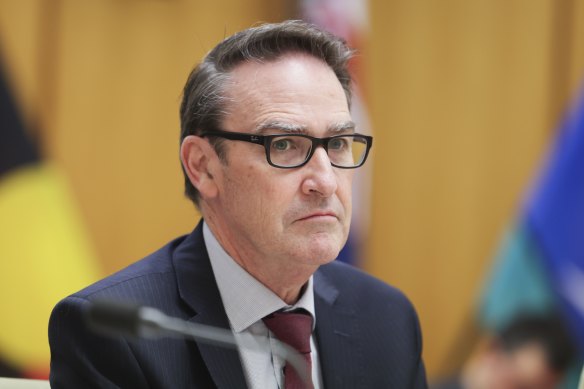This was published 7 months ago
Government to miss immigration targets again as Kiwis flock to Australia
By Shane Wright and Natassia Chrysanthos
Net overseas migration will overshoot the federal government’s budget forecasts as students attempt to stay in the country and New Zealanders leave their weak economy in search of a job in Australia.
In details that add to the pressure on Anthony Albanese and Immigration Minister Tony Burke to bring immigration and population growth under control, Treasury secretary Steven Kennedy revealed the May forecast of 395,000 net migrants in 2023-24 and 260,000 in the current financial year were out-of-date.

Treasury secretary Steven Kennedy says the government will not hit its own forecasts for net overseas migraton.Credit: Alex Ellinghausen
Since the reopening of the international border after the COVID pandemic, net overseas migration has surged to record numbers. In the 12 months to the end of September last year, a record 560,000 net migrants moved into Australia.
That has eased, but to the end of March it was still at 510,000.
Kennedy told a Senate committee that while immigration was easing, it was not falling fast enough for the government to hit its forecasts that were released in May.
“Lower-than-expected migrant departures mean that net overseas migration is likely to be higher in 2023-24 and 2024-25 than forecast at budget,” he said.
“Rather than depart, many migrants have extended their stay by applying for new visas, including permanent visas.”
There were 2.8 million overall temporary visa holders in the country at the end of the latest quarter – a figure slightly up from the same time last year, indicating the total number of people in Australia on short-term stays is growing rather than subsiding.
The number of student visa holders remains at a high, with 675,000 in the country, while those on temporary graduate visas has almost doubled since 2022 – from 115,000 to 228,000 – as foreign students seek to stay in Australia after their courses, putting pressure on the net migration figure.
Kennedy said one area that had caught Treasury by surprise was the lift in New Zealanders moving to Australia. Under the countries’ long-standing free trade agreement, there are few restrictions on movement by citizens between the two nations.
He said the weakness in the New Zealand economy, which has been effectively in recession for 15 months with unemployment on Wednesday increasing to 4.8 per cent, was leading to more Kiwis heading for Australia.
“It’s not unusual for us to see an inflow of Kiwis when their economy weakens more than ours and that has now come into play,” he said.
There were more than 720,000 New Zealanders in Australia on temporary visas at the end of September this year, which is a few thousand more than the same time last year but 40,000 more than in September 2022.
On Tuesday, the Reserve Bank revised down its forecasts for inflation but noted government spending – including the states and territories – was propping up overall economic demand.
She said Treasurer Jim Chalmers was “fully aware of the inflationary implications of his own policies”.
Kennedy, who sits on the RBA board, said since the federal budget, the states and territories had increased spending by about $20 billion for the current financial year.
He said federal spending had largely gone into Medicare services, the National Disability Insurance Scheme and the Pharmaceutical Benefits Scheme, noting all government spending was supporting the economy.
According to Kennedy, while the Reserve Bank focuses on underlying inflation – which is falling but at a relatively slow pace – most people were benefiting from a sharp drop in headline inflation.
“The reduction we have observed in headline inflation represents a material reduction in
cost-of-living pressures for households,” he said.
Kennedy revealed Treasury had modelled a series of scenarios based on the result of today’s US presidential election.
Donald Trump has promised to impose tariffs of up to 60 per cent. The independent Committee for a Responsible Federal Budget estimates the Trump agenda would increase American government debt by $US7.8 trillion ($12 trillion) by 2035.
According to Kennedy, who did not reveal the findings of the modelling, the work was done because there was “potential large increase in tariffs” that would pose a “potentially significant change” to existing policy.
“We thought it was worth to go and understand the impact of those policy changes, not only potentially on the US, but on our major trading partners, such as China and other countries, and then, of course, what the implications would be for us,” he said.
Cut through the noise of federal politics with news, views and expert analysis. Subscribers can sign up to our weekly Inside Politics newsletter.